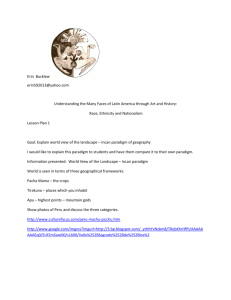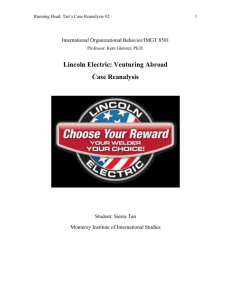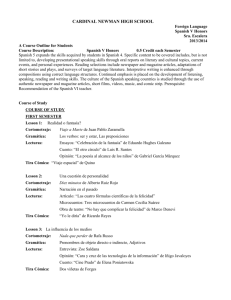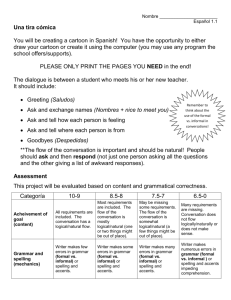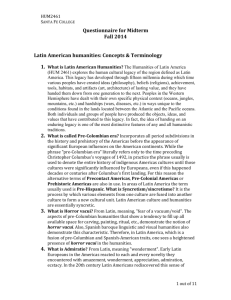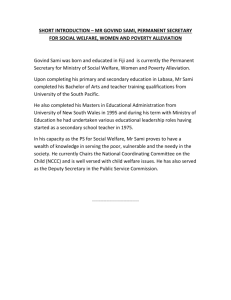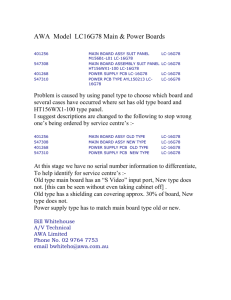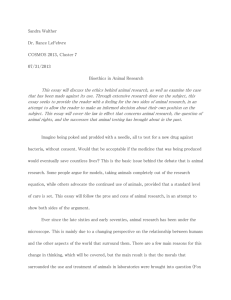Shade, Rachael
advertisement
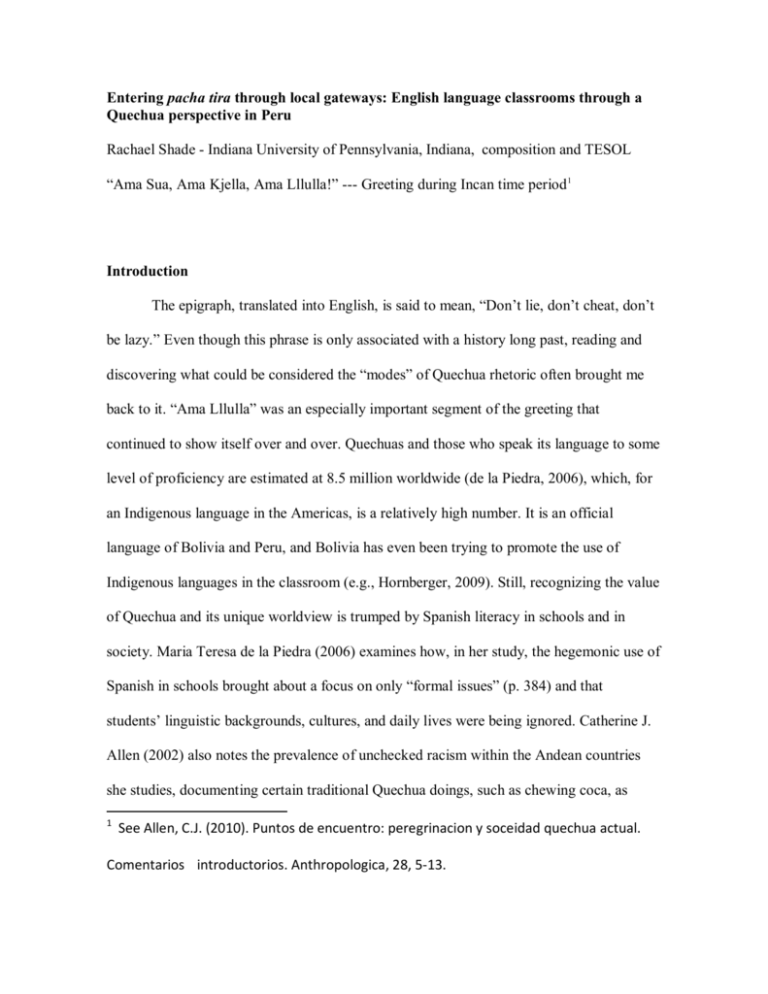
Entering pacha tira through local gateways: English language classrooms through a Quechua perspective in Peru Rachael Shade - Indiana University of Pennsylvania, Indiana, composition and TESOL “Ama Sua, Ama Kjella, Ama Lllulla!” --- Greeting during Incan time period 1 Introduction The epigraph, translated into English, is said to mean, “Don’t lie, don’t cheat, don’t be lazy.” Even though this phrase is only associated with a history long past, reading and discovering what could be considered the “modes” of Quechua rhetoric often brought me back to it. “Ama Lllulla” was an especially important segment of the greeting that continued to show itself over and over. Quechuas and those who speak its language to some level of proficiency are estimated at 8.5 million worldwide (de la Piedra, 2006), which, for an Indigenous language in the Americas, is a relatively high number. It is an official language of Bolivia and Peru, and Bolivia has even been trying to promote the use of Indigenous languages in the classroom (e.g., Hornberger, 2009). Still, recognizing the value of Quechua and its unique worldview is trumped by Spanish literacy in schools and in society. Maria Teresa de la Piedra (2006) examines how, in her study, the hegemonic use of Spanish in schools brought about a focus on only “formal issues” (p. 384) and that students’ linguistic backgrounds, cultures, and daily lives were being ignored. Catherine J. Allen (2002) also notes the prevalence of unchecked racism within the Andean countries she studies, documenting certain traditional Quechua doings, such as chewing coca, as 1 See Allen, C.J. (2010). Puntos de encuentro: peregrinacion y soceidad quechua actual. Comentarios introductorios. Anthropologica, 28, 5-13. being referred to as “dirty Indian habits” (The hold life has, p. 3). The longer one stays in formal schooling, the better one’s Spanish becomes. Unlike Spanish, Quechua is mainly an oral language with very little written materials to use in traditional classrooms. Despite societal forces working in their opposition, however, runakuna (how Quechuas refer to themselves) both young and old appear to be holding on to their language and way of life as much as they can (Bolin, 2006, p. 9). With this knowledge, I went to explore how, or whether, I could construct rhetorical “modes” a la Aristotle to be attributed to the runakuna. Thinking about the numerous definitions of rhetoric I have seen throughout the semester, I considered the possibility that the term “rhetoric” may not be fitting to use at all. Instead of “rhetorical modes” or “modes of persuasion,” I settled upon naming the theoretical framework for my project “modes of pacha tira.” The three pacha tira modes I will discuss here are sami/santu, k‘intu, and awa. I will present each mode individually, exploring its significance to the runakuna approach to life, learning, and resistance in a postcolonial society. Then, I will discuss how each mode might manifest itself in a composition classroom. Theory Why “modes of pacha tira”? Like the concept of rhetoric itself, pacha tira not stagnant or rigid. They are both constantly in a state of reformation and reconsideration about what is effective. Just like rhetoric, pacha tira can bring about the fruition of an idea (or a person) or destroy it. Unlike the concept of rhetoric, pacha tira is not so much about making an argument as it is about making a space. Both pacha and tira can be translated into meaning “land” or “earth,” but they are not quite the same. Firstly, tira comes from the Spanish word for land, tierra. Tira is associated with the material aspect of the world, what can be physically felt, while pacha refers to “the world existing in time” (Allen, 2002, p. 32) or “a moment in time” (p. 46). Pachas are always replacing one another, as the birth of one world or moment in time is the direct result of the utter destruction of the other. The idea of the death and birth of pachas can be traced back to the mythology behind the runakuna’s apocalypse mythos that will bring about the reign of the Incas once more. To give birth to a new idea or persuasion in the runakuna context would be to pass through a pacha, destroying the old one upon announcing its existence. Tira, the material world, of course, is not so readily destroyed 2 and remade as pacha. It is notable that tira does originate from Spanish, the language of the colonizer. The material land, the land of merchandise, of cities, of textbooks, of language policies and their (lack of) application relates both to tira and the dominant cultures of the Andean nations. It reminds me of modernity and how it has been used to place European cultures and thought at the center of the world, of tira. According to Walter Mignolo (2008), “Modernity appears when Europe affirms itself as the ‘center’ of a World History that it inaugurates: the ’periphery’ that surrounds this center is consequently part of its self-definition” (p. 8). Tira has whole-heartedly tried to take over pacha and turn it into something unchanging, into something akin to its own “self-definition.” However, for the runakuna at least, pacha is still strongly in place. Instead of one idea dominating the other, what has happened is a sharing of a concept. There is recognition of the influence that the dominant Spanish-speaking world has over everyone’s 2 Though, through an ecological perspective, one could argue that tira is easily destroyed. It is, however, often impossible to remake. way of life in the Andes. To reject how it has morphed runakuna society and language would be to reject the material world that surrounds everything. Then there is equal recognition of the importance of traditions and of the runakuna worldview. Pacha teaches us that worlds are constantly changing and that there can never rigid placements of people, languages or ideas. Therefore, the modes of pacha tira are ways of effectively presenting one’s place in this world and the world that has yet to come. These modes create the placement of writers and their ideas along not only what is presently physical and mental but also along what will come next. Using the modes of pacha tira means accepting how the outside world has influenced one’s thought while simultaneously accepting that these thoughts can break apart and be remade at any moment. Writers’ feet are on the solid ground, but they always need to anticipate, even encourage, earth quakes. Mode 1: Sami/Santu. This mode has dual parts, much like the entire concept of pacha tira. The word sami means “animating essence” and is transferred to people or sacred places by a number of ways. For example, when one burns coca leaves or blows on them in a ritualistic manner, sami is passed on to the earth. It is passed through food by the enticing smell of cooking it and even through beer and soft drinks because of the spontaneous, lively bubbles they make (Allen, 2002, p. 33). Essentially, anything that has an inherent power or force of life is considered to have sami, or samiyuq (possessive form of sami). People can also be samiyuq if they possess some kind of special talent or ability that are beyond the norm. The label of samiyuq is especially common for those who are exceptional musicians or public speakers. However, just like the smell of cooking fades away and the carbonation in soft drinks fizzles out, people who are samiyuq can also need time to regroup and renew. Since runakuna use their language primarily through oral means, it makes sense that they would value public speaking without necessarily putting much emphasis on written communication. For students, the first half of this mode would look deeply into the nature of their own pacha tira, discovering what in their lives gives them sami and when in life they feel that they are samiyuq. This part of the mode calls for understanding the essence of items/ideas/people inhabiting pacha tira and for how to best use this essence to ignite passion and excellence in one’s work (or to find the work that one is most passionate about). Public speaking, as far as I’m concerned, includes the teacher-scholar profession. In order to be an outstanding teacher, it is necessary to be samiyuq in regards to the subject matter and the students. Teacher-scholars who are samiyuq are capable of passing along their sami to students and the academic community as a whole, filling discouraged students and complacent colleagues with a new sense of life, determination and vivaciousness. The other half of this mode is santu or santuyuq, which comes from the Spanish word santo (saint, saintly). Someone who is santuyuq is “a person who has mastered a skill…The word santuyuq means possessing the Saints which…refers to the Saints responsible for inventing the skill” (p. 34). Here, just like in pacha tira, we see the duality of traditional runakuna culture alongside the dominant Spanish-speaking culture through language use. While samiyuq represents a kind of excited, elated spirit toward something, santuyuq represents control and precision, gaining mastery over something else. Both compliment each other, but seem very out of place and undesirable when they stand alone. Within Peruvian society, a good and current example of samiyuq without santuyuq is in its educational system’s implementation of bilingual intercultural education. This endeavor was born out of wishing to mimic global policies that encourage cultural pluralism and give greater access to Quechua-speaking students. Bilingual intercultural education is considered a key element to Peru’s current educational policy, however there is a serious lack of pedagogical application (Valdiviezo, 2010). Samiyuq without any sense of santuyuq just floats around out in the ether, ungraspable. Similarly, santuyuq without any sense of samiyuq leads to mechanical and lifeless actions and products. Imagine students needing to write an essay for a standardized exam or about a subject about which they feel absolutely apathetic. However, they know exactly what the test/teacher expects of them. They can churn out a formula and place transitional phrases masterfully and to the point where they receive high scores. This kind of situation will only breed disdain for writing or any subject. Therefore, it is essential to foster in students and in ourselves as teacherscholars both sides of this mode. Mode 2: K‘intu. The runakuna have very elaborate rituals when it comes to the uses of coca leaves. They are burned, chewed, and blown upon. They are used for divination, to spread sami, and to fortify relationships between people and between the Earth and its sacred places. Coca leaves are called k’intu, and this mode will only focus on one of k’intu’s usages: the ritual of blowing on leaves, or phukuy. Doing phukuy means calling upon the Earth and upon specific places, local and regional. The sense of a “hierarchical sense of space” is exceedingly important to runakuna. When they travel, it is necessary to approach the strange land with caution. The sacred places in the new space are more than likely going to frown upon their intrusion. In order to assure safety, runakuna blow their k’intus to the new location so as to introduce themselves. When in a familiar space, phukuy can be directed at people as well as places. There is usually a brief invocation of sorts which is either whispered or said loudly. In the latter case, phukuy can be used to express fright or anxiety in an indirect way. For example, blowing over one’s k’intu asking to do well on a paper would let nearby people know of one’s nervousness without stating it explicitly. It acts as a call for support from others. (Allen, 2002, p. 107). The act of invocation with phukuy, whether it be loudly or softly, to express emotion and forge relationships of all kinds, is similar to Quechua-speakers use of music and lyrics between each other. Since runakuna have historically been (and in less overt ways still are) considered the Andean “underclass,” their music functions as a way of maintaining solidarity in a society that all too often acts violently or apathetically toward them (Saroli, 2005). Both music and the ritual blowing on leaves create harmony between people, places, and emotions. How do we perform the mode of k’intu in composing and in teaching? This mode, theoretically, would explore how students and teacher-scholars alike make peace with their pacha tira through writing. Living in worlds that could break apart at any moment, there needs to be a way to cement at least some relationships so that we are not all alone if things crumble more than we expect. Often, students and teacher-scholars are up against a society that is hostile to their identities and their ideas. Through the mode of k’intu, one realizes that pacha tira is not something that is experienced alone but that others often are reaching out for the same solidarity, the same assurance, and the same comfort in the face of great anxieties. Mode 3: Awa. As I continued to do research for this project, I thought it curious that the Incas, ancestors of Quechua-speakers today, never developed a system of writing of their own. Other great civilizations in the pre-colombian Americas had them, so why did the Incas not? Then, after delving more deeply into forms of communication within contemporary runakuna societies, I discovered that I had been formulating my question poorly. There is a way that the runakuna communicate that is akin to a writing system. Perhaps one might even consider it to be a writing system all on its own. What might puzzle the outsider at first is the medium of communication. Textiles, specifically awa, or weaving, are used to communicate worldviews, cultural ideas, resistance, and injustice. Andrea M. Heckman (2003) reports that “[weavers] can still identify the mythical meanings of each distinct symbol. In some regions, a specialized vocabulary exists for the type, shape, and meanings of particular symbols. Weaving in these ways is the vessel through which many teachings are transported and publicly displayed” (p. 22). She further remarks on the impressive persistence of this form of nonverbal communication between runakuna, especially as all of our tiras are becoming increasingly homogenized in everything, including the way we express ourselves. The use of awa as a means of communication despite outside pressures to use forms such as writing creates a sentiment of nonconformity when displayed or worn. It fosters the concept of a closed society even though there are outward moves toward assimilation with the dominant culture, such as an increasing amount of young Quechua-speakers moving to more urban areas and receiving more formal education (Bolin, 2006). The mode of awa is the mode of pacha tira that appeals to resistance to some of the earth quakes and rifts as moments in worlds are born, destroyed, and reborn. It recognizes that not every death of a world is a cause of enlightenment, epiphanies, or discoveries. Some of the cracks in pacha tira might have been caused by someone or something else, with ideologies that wish to constrict or even fully replace the ones that the individual values dearly. The use of awa for students and teacher-scholars means, firstly, realizing the threat to the current pacha tira is an unhealthy one; secondly, it means that employing alternative and innovative ways might be necessary in preserving as much of pacha tira as possible. The mode awa is probably best used when being overt about one’s stance might cause substantial backlash, and explicitly not conforming to a policy or a school of thought could put people’s security in jeopardy. This paper will conclude by discussing ways that I envision a first year composition classroom being run if a teacher-scholar were to adopt the modes of pacha tira. Practice Classroom setup. The classroom atmosphere within the modes of pacha tira would be recognizing just how important our relationships are to our physical and emotional health, because the world could fall apart and start all over again at any time. Stressing how vital the relationships are between students, teacher, their surroundings, and their writing will be a key component to the way classes should be conducted. The students and teacher should always sit in a circle and try to sit beside someone new each class or at least in a different spot. The teacher should draw students’ attention to how they interact with each other on different days and while doing different activities. What about the classroom setup helps them be samiyuq or santuyuq? What hinders these states of being? In what ways do students forge relationships between peers, teacher, and the place that they are in? What is their k’intu ritual with each group? Do they feel a need to use awa in some instances as a form of resistance or a way of covertly expressing a message? Why did they choose to do this? In addition, a classroom setup that adopts these ideas would foster preparedness in students to go through the birth-destruction cycle of pacha tira. The instructor should assure students that part of being in the class is looking at different viewpoints, some of which they will be opposed to, some of which might change their minds completely, and some of which might strengthen the views that they already have. The students should be ready to hear and write about things that may cause earth quakes. If possible, the instructor should try to change where the class meets from time to time. This paper has shown the concept of place and humans’ relationships with it to be very important. The instructor could use the opportunity to discuss how the change in environment has had or not had an impact on their thoughts and their writing. The teacher should do his or her best to establish a mentoring relationship and avoid much authoritarian behaviors. The instructor, of course, has to keep order in the class. A good way to avoid needing to be imposing on student behavior in class is to have the teacher and the student body decide on rules of conduct on the first day of class. The instructor would only act in a correctional way when something a student states or writes is not factual. As a matter of fact, students ideally would feel free enough to correct each other in such an event, and do it in a way that does not drive people apart but further strengthens bonds. When creating a code of conduct, perhaps some manner of k’intu ritual could be created to indirectly tell someone that they might be mistaken. Using this method, no one would be embarrassed and no one would have to feel like they were imposing themselves upon another. Syllabus design. The objectives in the syllabus should be to 1) prepare students for the shake-ups in views and beliefs they will encounter through writing, 2) guide students in finding the spirit of joy and acquiring greater control of expression through writing, 3) demonstrate the necessity of human and non-human relationships as shifts and changes happen in life through writing, and 4) discover alternative ways of expressing an idea, injustice, and personal worldviews in a society that is restricting the number of acceptable mediums by which we communicate. Any required books or readings should always show both sides of an argument. Policies regarding turning in late work, tardiness and absence might be strict. Turning in late assignments, disrupting class by being tardy, and not showing up at all puts strain on the relationships between the instructor and the other students. The class as a whole would decide when turning in an assignment late is acceptable, if at all, and when there should be a penalty. Also, using electronic devices at inappropriate times could interrupt the transference of sami or distract someone to the point where they are not as santuyuq as they could be. However, if students feel that any of the classroom policies are preventing them from being overt about their ideas and expressing their concerns might cause backlash, they should feel free to resist through the mode of awa 3. The scheduling of the syllabus would probably not differ too much from the traditional setup of a syllabus calendar, at least at first. There should be a disclaimer at the top of the schedule that not only is the schedule tentative and subject to change, but that it could change at any moment. Items such as due dates would be left in tact, but the teacher would reserve the right to change the readings for the next week, to use a different activity than announced on the schedule, or to ask students to take a different stance on an issue than the one they agree with. 3 I don’t know how wise this would truly be, but ideally students should be allowed to use any of the modes of pacha tira at any time during the class, even if, perhaps especially if, the instructor disagrees. Assignments. Assignments should always reflect the idea of pacha tira, accepting that the outside world influences us while also accepting that our worlds are constantly being destroyed and born anew. Writing assignments should include journaling or blogging to record how students’ views have changed or been challenged and what their reactions are to that. They should be encouraged to do one larger writing assignment (5-6 pages) that focuses on what makes them be samiyuq. Having this part of the dual mode, students could work on becoming more santuyuq in the craft of writing, be it through workshops at the Writing Center, peer review days, or even days in which students have to express the topic of their paper through the mode of awa. Using awa could be anything from using pipe cleaners to make sculptures related to their paper’s message to bringing in a flower arrangement that represents the purpose of the paper. There could be a shorter writing assignment that closely examines how students’ relationships with a friend, family member, or place has affected who they are and why the have made the choices they have thus far in life (3-4 pages). They should develop a form of k’intu ritual within the paper that indirectly states what the author is feeling and what actions the reader can take to help. This could be done through the form of a poem, prayer, mantra, wish, drawing, etc. Another kind of writing assignment that would fit would be a paper that delves into the heart of an argument, one that may likely cause rifts in pacha tira (3-5 pages). In order to complete this assignment, students would be asked to take a side on an issue, present both the argument they started out with and the counterargument, and convince the reader why their current take on the argument is correct. Students may ultimately decide that they agree more with the counterargument after doing research, or they may find a way to consolidate the two. Doing the research could just as well strengthen their position further. Either way, destruction and birth in pacha tira take place, and the students would have to reflect in the paper on the changes their viewpoint when through. The last kind of assignment could be something that is wholly focused on the mode of awa. Students would not be permitted to use writing or any socially sanctioned medium of communication, such as paper, word processors, social networking, videos, Power Point, poster boards, etc. They would be required to devise their own symbolic code of communication, create a message using it, and then explain it to the class. The mediums of use could be anything from clay to pillow cases to biscuits, just as long as it is not considered to be a “normal” medium to express ideas. Assessment. The last sub-topic under Practice that I will discuss is that of how to assess students in this kind of classroom environment. I believe that the assessment of written materials through the “primary traits” method would work best. Using primary traits would mean that the entire class generates and agrees upon a list of what traits each assignment should have and should not have. While this may take a little prodding with the first assignment, students do catch on and will be able to generate a primary trait list for the next assignment quickly. The primary trait method of assessment follows along with pacha tira, especially for the teacher who gives up control over designing rubrics and needs to be flexible in case the list causes a pacha to die away. It also gives students more control over whether being samiyuq or santuyuq should be given more preference in assessment or whether they both deserve equal weight. Conclusion There are other modes that could be considered under pacha tira. I have only listed three here because there is, as always, a limited amount of space. While I have discussed how the application of sami/santu, k’intu, and awa might look like in the composition classroom, no studies to my knowledge have been done about how these concepts actually manifest. This paper was written to answer a call to consider forms of rhetoric that step outside of the Western canon. I believe that it has succeeded mostly in its theoretical section because, without any data to inform my decisions, I can only abstractly envision how practical application of the modes of pacha tira would be received by students and teachers alike. It could be that this approach to a writing class would be considered ineffective, especially the mode of awa which challenges our privileged society’s very concept of a communicative medium. Teachers also may not be so comfortable in allowing students as much control in the classroom as this approach would allow. Even though student-centered classrooms are in vogue, the teacher still has to keep order and still has to assign grades. Despite its numerous flaws, I believe that this project is ultimately a success because it has added to the concept of rhetoric by bringing a widely disregarded culture’s worldview and ways of communication to the spotlight. References Allen, C. J. (2002). The hold life has: Coca and cultural identity in an Andean community. Washington: Smithsonian Institution Press. Bolin, I. (2006). Growing up in a culture of respect: Child rearing in highland Peru. Austin: University of Texas Press. De la Piedra, M. T. (2006). Literacies and Quechua oral language: Connecting sociocultural worlds and linguistic resources for biliteracy development. Journal of Early Childhood Literacy, 6(3), 383-406. Heckman, A. M. (2003). Woven stories: Andean textiles and rituals. Albuquerque: University of New Mexico Press. Mignolo, W. (2008). Delinking: The rhetoric of modernity, the logic of coloniality, and the grammar of de-coloniality. Cultural Studies, 21(2/3), 1-75. Saroli, A. (2005). The persistence of memory: Traditional Andean culture expressed in recurrent themes and images in Quechua love songs. Confluencia, 20(2), 47-56. Valdiviezo, L. A. (2010). Indigenous worldviews in intercultural education: Teachers’ construction of intercultural in a bilingual Quechua-Spanish program. Intercultural Education, 21(1), 27-39.
